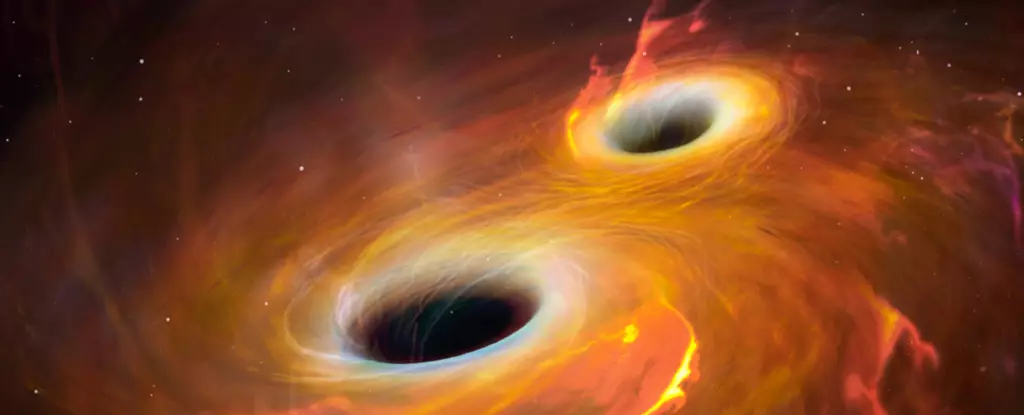At the very heart of our galaxy lies a phenomenon that has captivated astronomers and curious minds alike—a supermassive black hole known as Sagittarius A* (Sgr A*). This enigmatic entity is not isolated; it exists amidst a chaotic environment filled with swirling gas, cosmic dust, and young stars. However, the true dynamics of this region remain largely shrouded by heavy interstellar material, making direct observations incredibly challenging. Traditional observational techniques, particularly in the visible spectrum, are rendered ineffective due to this obscuring veil. To navigate this cosmic conundrum, researchers have turned to infrared and radio wavelengths, slowly unraveling the mysteries that dwell within this stellar neighborhood.
Astounding as it may seem, the heart of our galaxy could be more densely packed with stellar remnants—specifically, stellar-mass black holes—than we ever anticipated. Yet, despite the theories and increasing curiosity, one significant question lingers: How many stellar-mass black holes reside near Sgr A*? Current models yield a disparity in estimates, ranging from a mere few hundred to the daunting prospect of millions, raising eyebrows and igniting heated debates in the scientific community.
The Star Grinder: A Revolutionary Concept
A groundbreaking study published in Astronomy & Astrophysics has recently introduced a compelling new hypothesis referred to as the “Star Grinder.” This novel model posits that the galactic center’s peculiar density of gas and dust could potentially serve as a breeding ground for massive stars—specifically, O-type and B-type stars—whose immense gravitational forces and short lifespans lead to explosive ends as supernovae. The heart of the matter lies in their collapse, forming black holes while simultaneously ejecting stellar matter back into the cosmic mix, fostering new star formation.
If this theory holds any water, the black holes could accumulate rapidly, leading to a dynamic interplay of creation and destruction. The gravitational dance of stars and black holes could accelerate star formation, making the region an ever-evolving crucible of stellar evolution. Collision events would become a routine occurrence, effectively churning celestial bodies within this cosmic coffee grinder—a metaphor that captivatingly captures the concept’s essence.
Importance of Collision Time in Testing the Hypothesis
To further validate their theory, the study’s authors delve into a statistical mechanism known as collision time. This analytical framework posits that, given a specific density of black holes, the likelihood of a star encountering a black hole can be quantified over a defined period. Higher densities lead to shorter collision intervals. Interestingly, the mass of the star plays a pivotal role; the larger the star, the greater its chances of encountering a black hole.
Through meticulous calculations that mapped the potential collision scenarios, the authors were able to pinpoint the expected behavior of stars in the Sgr A* vicinity. Their analysis revealed a disconcerting trend: fewer O-type stars exist at the galaxy’s center compared to other regions, indicating that these massive stars may be falling prey to the gravitational ballet orchestrated by numerous black holes. In contrast, the relative abundance of smaller B-type stars suggests they experience far fewer encounters, a clear signal of the cosmic grinder’s brutal efficiency.
Implications of the Star Grinder Model
The implications of the Star Grinder hypothesis extend beyond mere speculation. If accurate, the study proposes that there could be approximately 100 million stellar-mass black holes in close proximity to Sgr A*. Such a staggering figure challenges preconceived notions about the black hole population and opens avenues for more extensive investigations into cosmic phenomena. Moreover, this model provides a plausible explanation for the existence of hypervelocity stars—celestial bodies traveling with such staggering velocity that they can escape the Milky Way’s gravitational grasp. According to the hypothesis, these high-speed stars could result from close encounters with black holes, a chilling reminder of the violent processes that dominate the galaxy’s heart.
As researchers continue to analyze data in an effort to validate the Star Grinder model, one can’t help but marvel at the complexities and interstellar chaos that characterize our galaxy’s center. The heart of the Milky Way may very well be an enigmatic forge of matter, where stars are born, collide, and ultimately succumb to the relentless pull of black holes. Such revelations not only deepend our understanding of the universe but also prompt conversations about the fundamental nature of creation and destruction in cosmic realms.


Leave a Reply